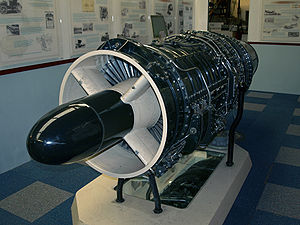Armstrong-Siddeley Sapphire
| Sapphire | |
|---|---|
 |
|
| Preserved Armstrong Siddeley Sapphire at the Midland Air Museum |
|
| Type | Turbojet |
| Manufacturer | Armstrong Siddeley |
| First run | 1 October 1948 |
| Major applications |
Gloster Javelin Handley Page Victor Hawker Hunter |
| Variants | Wright J65 |
The Armstrong Siddeley Sapphire was a British turbojet engine produced by Armstrong Siddeley in the 1950s. It was the ultimate development of work that had started as the Metrovick F.2 in 1940, evolving into an advanced axial flow design with an annular combustion chamber that developed over 11,000 lbf (49 kN). It powered early versions of the Hawker Hunter and Handley Page Victor, and every Gloster Javelin. Production was also started under licence in the United States by Wright Aeronautical as the J65, powering a number of US designs.
Design evolution of the Sapphire started at Metropolitan-Vickers (Metrovick) in 1943 as an offshoot of the F.2 project. With the F.2 reaching flight quality at about 1,600 lbf (7,100 N), Metrovick turned to producing larger designs, both an enlarged F.2 known as the Beryl, as well as the much larger F.9 Sapphire. (The names were chosen after a decision to use gemstones for future engine names). The Beryl eventually developed 4,000 lbf (18 kN) thrust, but the only project to select it, the Saunders-Roe SR.A/1, was cancelled.
In 1948 Metrovick exited the jet engine industry. Armstrong Siddeley, who already had a turbine development of their own, the ASX, took over the MVSa.1, now renamed ASSa.1, and redesigned it as the ASSa.2.
In December 1949 the ASSa.2 completed an acceptance test at 7,380 lbf (33 kN). Its competitor, the Avon Ra.3 had a design thrust of 6,500 lbf (33 kN) at that time. A number of companies expressed interest in the Sapphire, and it was considered as either the main or backup powerplant for most British designs of the late '40s and early '50s.
The ASSa.5 with 7,500 lbf (33,000 N) thrust was used only on the English Electric P.1A, prototype for the Lightning. A simple fixed-nozzle reheat was fitted to extend the performance boundary for stability and control testing from about Mach 1.1 to beyond Mach 1.5. Future versions of the Lightning were powered by the Avon.
...
Wikipedia
